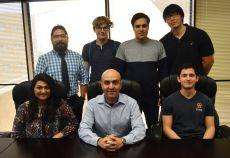Researchers to develop new math theory for improvement of imaging technology

Researchers at The University of Texas at Arlington are working on a project which could have a sizable impact on imaging technologies, by developing new mathematical theories that can help solve outstanding problems.
Technologies using imaging that could benefit include: modern healthcare equipment, national security, space exploration and industrial applications.
Gaik Ambartsoumian, UTA associate professor of mathematics, is principal investigator of the project, titled "Conical Radon transforms and their applications in tomography," which is funded by a three-year grant from the National Science Foundation's Division of Mathematical Sciences.
Tomography is a technique for creating three-dimensional images of the internal structures of a solid object by analyzing the travel of waves of energy, such as X-rays, electromagnetic or acoustic waves, through the object.
The techniques directly related to Ambartsoumian's project include single-scattering optical tomography and gamma ray emission tomography, which are used in medicine for diagnostics and treatment monitoring of various diseases. The project also focuses on Compton camera imaging, which is used for detection of radiation sources in homeland security and in radio astronomy; and a few others, he said.
"We are working on the development of a new mathematical theory necessary for the advancement of imaging techniques in optical tomography and cameras using Compton scattering effect," Ambartsoumian said. "More specifically, we are studying the properties and deriving inversion formulas and algorithms for the broken-ray and conical Radon transforms, which are at the forefront of scientific endeavors in modern integral geometry and inverse problems."
Jianzhong Su, professor and chair of the Department of Mathematics, said the project has the potential to improve the technology used to diagnose and treat cancer and other diseases, which helps further UTA's commitment to improving health and the human condition, one of four pillars of the University's Strategic Plan 2020 Bold Solutions | Global Impact.
"Dr. Ambartsoumian's project can help to make key improvements in the effectiveness of various methods of tomography," Su said. "Improving these transforms can lead to greater accuracy of the images obtained from imaging modalities such as computed tomography, which is also known as CT, and ultrasound scanning, and could lead to improved airport security and advances in space exploration."
Ambartsoumian is joined in the work by co-PI Venkateswaran Krishnan, a faculty member in the Center for Applicable Mathematics at Tata Institute of Fundamental Research in Bangalore, India, and by three doctoral students working in Ambartsoumian's group: Sl-Ghi Choi, Mohammad Javad Latifi Jebelli and John Montalbo.
The project also provides research experience to three to four undergraduate students, who are exposed to sophisticated mathematics with applications to real-world problems. This year, undergraduate students Srivani Gandikota, Brendon Hotchkiss and Javier Salazar will participate in the project. Special emphasis is being made on training students from groups historically underrepresented in STEM fields, including women and minorities, Ambartsoumian said.
Provided by University of Texas at Arlington



















